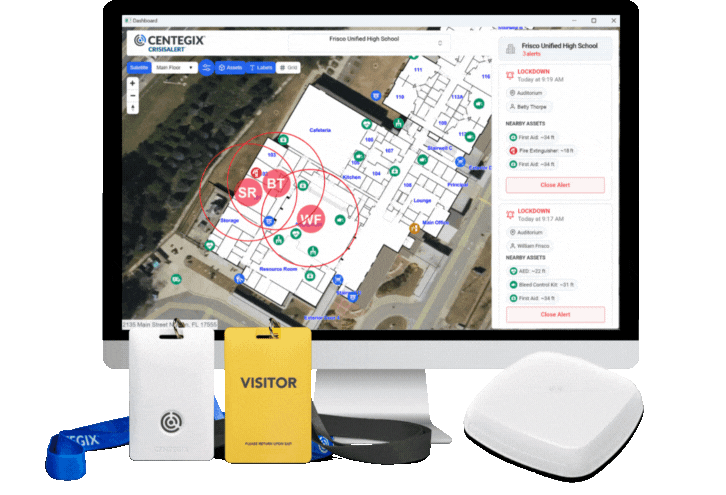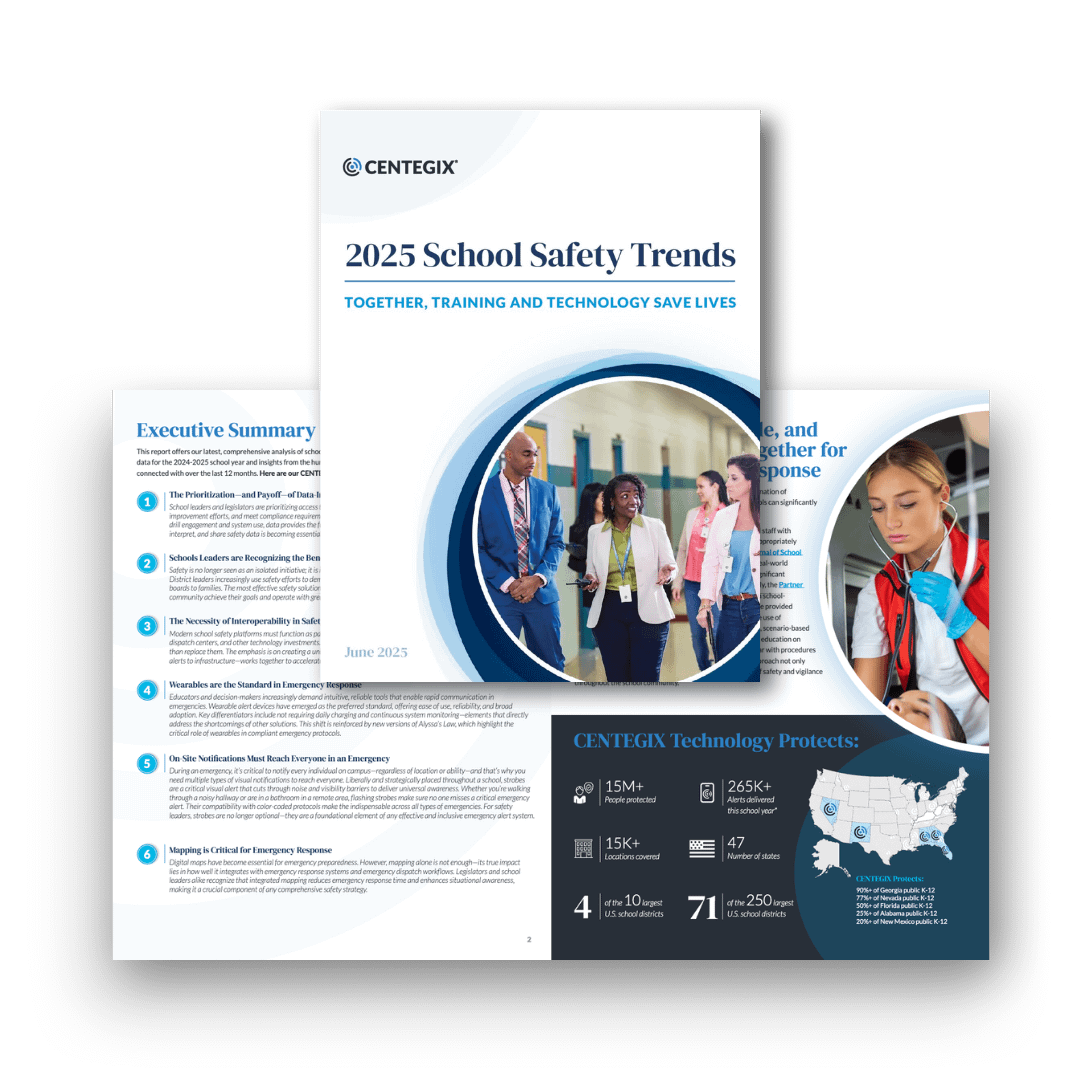CENTEGIX | Education
Arizona School Safety Standards
CENTEGIX | Education
Arizona School Safety Standards
Tucson Arizona School Districts Choose CENTEGIX CrisisAlert Wearable Panic Buttons for Peace of Mind
In the past we struggled with moving the ball forward as quickly as the public has demanded with regards to security and safety of students and staff. This is going to represent a significant move forward.
Arizona School Safety Program
The Arizona School Safety Program is a competitive, state-funded grant focusing on safety in schools that runs in three-year cycles. Per Arizona Revised Statute 15-154, “the School Safety Program is established within the department of education to support, promote and enhance safe and effective learning environments for all students by supporting the costs of placing school resource officers (SRO), juvenile probation officers (JPO), school counselors and school social workers on school campuses.” Arizona public schools and charters are eligible to apply.
Using robust prevention and intervention approaches, officers funded by the School Safety Program:
- maintain a visible presence on campus
- deter delinquent and violent behaviors
- serve as an available resource to the school community
- and provide students and staff with Law-Related Education instruction and training
These efforts result in positive, engaging relationships between officers and students, staff, and other community members they serve. Programs like these that are proactive and prevention-based are cultivated through partnerships based in collaboration between officers, school administration, teachers, and police and juvenile probation departments.
School Safety Program Goals and Objectives
Goal: The School Safety Program contributes to an orderly, purposeful atmosphere, which promotes the feeling of safety conducive to teaching and learning. Goal objectives:
- Staff feels that the school is safe, and administration supports and monitors the consistency of actions/strategies/policies that will improve or maintain that feeling of safety.
- Students feel that the school is safe. They feel free from the threat of physical harm and verbal abuse. They feel they have an adult to go to with their safety concerns, and they feel their concerns are taken seriously and addressed.
- Staff and students have a positive view of the SRO/JPO.
Goal: To teach Law-Related Education that promotes a safe, orderly environment, and good citizenship. Goal objectives:
- The Arizona State Board of Education oversees the process to ensure the continuous review and provision of instructional materials that promote a safe, orderly environment, and good citizenship
- Officers conduct 180 hours of Law-Related Education instruction per year.
- Officers annually attend an Oversight Committee approved Law-Related Education academy/class to enhance their classroom skills and knowledge of appropriate LRE lessons.
Learn more about the School Safety Program and how to obtain funding for your school here.
Title IV-A Safe and Healthy Students Program
It is the goal of the Title IV-A Safe and Healthy Students program to provide support to LEAs and schools across Arizona so all students can experience a healthy, safe, and supportive learning environment, one that focuses on the physical and mental health and well-being of students.
According to the program’s website, “a safe, healthy, and supportive school environment is the product of a school’s attention to fostering safety; promoting a supportive academic, disciplinary, and physical environment; and encouraging and maintaining respectful, trusting, and caring relationships throughout the school community, focusing on the fostering of positive conditions, climate, and culture, including family and community engagement.”
Learn more about the program by visiting the program website.
Arizona Schools Emergency Response Plan Requirements
According to the Arizona Department of Education, “Arizona Revised Statutes (ARS) 15-341 (A) (31) requires each school site to have an emergency operations plan (EOP) that meets the minimum state requirements. The Arizona Department of Education (ADE) and the Arizona Department of Emergency and Military Affairs, Division of Emergency Management (AZDEMA) are for developing the minimum standards for school emergency operations plans in Arizona.”
To help schools meet the requirements, the Arizona Dept. of Ed. compiled the Arizona Schools Emergency Response Plan Minimum Requirements guidance document, which details the required elements to be included in every schools’s emergency response plan. The standards are simply a minimum of what should be included in the plan and not a systematic guide for completing a comprehensive response plan.
Explore the guidance document here.
Additional Funding for Arizona School Safety Solutions
Stronger Connections Grants
In late 2022, the U.S. Department of Education announced nearly $1 billion in awards through the Bipartisan Safer Communities Act (BSCA). In Arizona, the Stronger Connections grants aim to provide students with safe and supportive learning opportunities and environments critical for academic success. Arizona was awarded $19,785,580 through this program.
Through the BSCA, Congress awarded $1 billion in funding to state educational agencies (SEAs) to develop state grant programs to give students safer and healthier learning environments. The BSCA specifies that SEAs must award these funds competitively to high-need LEAs, as determined by the state.
This grant focuses on helping schools foster sustained learning, engagement, and attachment for students in Arizona schools. The Stronger Connections Grant Program mandates that schools should accomplish this by becoming more resilient, supporting mental health, and improving school climate.
According to the Department of Education, schools should spend Stronger Connections Grant Program funds to:
- Implement evidence-based strategies that meet students’ social, emotional, and mental well-being needs.
- Create positive, inclusive, and supportive school environments.
- Increase access to place-based interventions and services.
- Engage students, families, educators, staff, and community organizations in selecting and implementing strategies to create safe, inclusive, and supportive learning environments.
- Design and implement policies and practices responsive to underserved students, protecting student rights, and demonstrating respect for student dignity and potential.
Spending that qualifies for funding could include hiring counselors and nurses, providing teacher training on inclusion and behavioral interventions, expanding mental and behavioral services, and other related efforts to create a positive and supportive climate in Arizona schools.
COPS School Violence Prevention Program
The U.S. Department of Justice oversees the COPS School Violence Prevention Program. The money is earmarked for evidence-based school safety programs and technology.
Schools can use those funds to purchase school safety technology that helps identify potential dangers. The money can also be used to improve emergency notification and response systems. To learn more, visit the COPS website.
BJA’s STOP School Violence Program
The U.S. Department of Justice also has funds available through the Bureau of Justice Assistance. BJA’s STOP School Violence Program funds software that helps K-12 schools maintain a safe environment. It’s geared toward recognizing, responding to, and preventing violence on campus. Learn more here.
Federal Grants
The list of federal grants awarded to Arizona for the 2022-23 school year includes:
- IDEA ARP: $45,865,367
- IDEA: $289,798,643
- Title I: $758,287,273
- Title IV-A: $24,786,468
CENTEGIX Webinars
Leveraging Safety to Improve Teacher Retention and Recruitment | March 2024
Harm Mitigation: Keeping Your Staff Safe | March 2024
School Emergency Response: A Police Chief’s Perspective | April 2024
School Safety: Keep It Easy | April 2024
How Are Your Resources Being Spent?
CENTEGIX protects over 15,000 locations across the country. We can protect yours, too.
The CENTEGIX Safety Platform™, featuring CrisisAlert™, accelerates your response to emergencies. We’ve built the CENTEGIX Safety Platform to support you in the single most critical factor of incident response: time.
Discover federal resources to fund new safety and security initiatives in your district by exploring federal funding resources for school safety.

CENTEGIX Safety Report
2025 School Safety Trends: Together, Training and Technology Save Lives
Discover our latest, comprehensive analysis of school safety incidents gathered from the CENTEGIX Safety Platform™ usage data for the 2024-2025 school year, as well as insights from the hundreds of school safety and district administration leaders we’ve connected with over the last 12 months, in our report 2025 School Safety Trends: Together, Training and Technology Save Lives.
Download your copy today.

Hear from Our Educators
We engage with teachers and staff every day to understand how CrisisAlert supports them, and here’s what they’ve shared:
A student was having trouble breathing and her vision was beginning to black out. We don’t have service in our building and it can be difficult to get ahold of the office staff, so having something to immediately alert them of emergency was incredibly helpful in a very scary situation.
I had a student who was refusing to follow directions and became very defiant. This student was beginning to get aggressive. I used my badge to alert our campus security monitor to remove the student from the situation. It is a very useful tool when the response was as immediate as it was.
A student was having a severe panic attack, trouble speaking, crying, not able to answer my questions as to what was wrong with her. I used the device to call for administrative help and it worked like it was designed to. Help arrived in a matter of seconds. I saw firsthand how well it works.
The Safety Platform™ Meets Grant-Funded Safety Measures
The CENTEGIX Safety Platform is an emergency incident response safety system that features wearable panic buttons, digital mapping software, and reunification and visitor management capabilities and generates accurate, usable data. The Safety Platform solution uses visual strobes, digital messages, and automated intercom announcements to inform everyone of a campus-wide incident and to instruct them on actions they should take. The Safety Platform meets the security infrastructure needs the Arizona school safety grants aim to address.
The Safety Platform features an analytics dashboard that assists administrators as they make safety and security decisions. A data set is generated when a staff member uses their wearable badge to request assistance. Administrators can better understand where and why and under what conditions. These administrative decisions, enabled by Platform data, contribute to the “positive and safe climate” that the safety grants aim to foster.
The CENTEGIX school safety platform provides robust and uninterrupted communication between staff members, administrators, first responders, and students. Unlike other emergency incident response systems, the Safety Platform’s technology precludes adoption and connectivity challenges. It runs on a dedicated IoT network; it’s not susceptible to Wi-Fi or cellular connectivity interruptions. And because the CrisisAlert mobile panic button is worn along with an ID badge, 100% of staff members use it. This high adoption rate means that every staff member at every location on campus can request help when they need it. CrisisAlert generates accurate location data for every alert, no matter where on campus. Therefore first responders know exactly where to go during an emergency. In many instances, this kind of rapid response can prevent tragedy.
These critical features of the CrisisAlert badge and Safety Blueprint from CENTEGIX ensure an immediate response:
Desktop takeover notifications for staff mean campus-wide alerts are never missed.
Location accuracy enables rapid response.
The system immediately connects the parties best prepared to handle the situation.
Wi-Fi and phone outages have no effect on the system.
Wearable security badges are easily accessible, lightweight, and wearable.
CENTEGIX Safety Platform can help school districts and LEAs enact these measures, making students and staff safer. The Safety platform school safety solution helps create a climate of safety by enabling staff members to request help immediately, from anywhere on campus, in any type of emergency. Under these conditions, teachers can focus on student needs, and students can focus on learning.
CENTEGIX is the leader in incident response solutions. CENTEGIX innovates safety solutions to empower and protect people every day. Leaders nationwide trust our safety solutions to provide peace of mind in the workplace. Our Safety Platform is the fastest and easiest way for staff to get help in an emergency, from the everyday to the extreme.
Championing Safe Schools with Educators and Educator Associations
Discover the Safety Platform
Safety solutions that prioritize speed for the best outcome.
Mapping and locating capabilities provide the precise location—of emergencies, visitors, and safety assets.
A visitor management system screens and locates visitors on your campus.
Protocol development to plan for rapid incident response.
CrisisAlert Is in a Class of Its Own
We don’t just raise the bar. We built it.
CrisisAlert leads the industry in wearable panic button technology. As the most trusted, proven, and deployed solution on the market, it delivers unrivaled reliability, redundancy, notification, and response capabilities.
Unlike other wearable panic buttons, CrisisAlert activates a fully integrated emergency response and notification system, including flashing strobes, intercom announcements, and computer screen takeovers. It’s the only solution with 100% campus-wide coverage that immediately sends a digital map to first responders with precise location details, down to the exact floor and room, detailing every safety asset in proximity of the alert, to protect your staff wherever they are.
In an Emergency, You Need CrisisAlert™
Adverse situations can happen at any moment—from everyday crises such as medical emergencies, severe weather, and physical altercations to extreme situations that threaten your entire campus. The faster you get help to the right location, the better the outcome.
See how our CrisisAlert wearable mobile panic button empowers staff to get help instantly in an emergency.
Ready to Connect with a CENTEGIX Specialist to Learn More?
"*" indicates required fields
*By providing my phone number to CENTEGIX, I agree and acknowledge that CENTEGIX may send text messages to my wireless phone number for any purpose. Message and data rates may apply. CENTEGIX will only send one SMS as a reply, and I will be able to Opt-out by replying “STOP”. **No mobile information will be shared with third parties/affiliates for marketing/promotional purposes.*

Empower Your Educators
with Safety
Explore More Safety Resources
2025 School Safety Trends Report
This report offers our latest, comprehensive analysis of school safety incidents gathered from the CENTEGIX Safety Platform™ usage data for the 2024-2025 school year.
Visitor Management: Best Practices for Your School Safety Plan
CENTEGIX empowers thousands of schools to take control of their visitor management and protect their teachers, students, and staff. Get a copy of our Visitor Management Best Practices Guide today.
Supporting the Unique Safety Needs of Special Education Students and Staff
In our case study, learn how Meade County School District has supported and empowered their special education staff and students with the CENTEGIX Safety Platform™.
School Safety Standards by State
Schools in any state can meet school safety grant funding requirements by choosing the CENTEGIX Safety Platform™. Learn more about school safety in your state.

Creating Safer Environments: Leadership Strategies to Prevent Workplace Violence in Healthcare
Violence in healthcare isn’t just a growing concern—it’s a persistent crisis. Get actionable insights for leaders ready to fight workplace violence in this AHA Associate Podcast.

Reliability is Key to Effective School Safety Solutions
CENTEGIX CrisisAlert is a reliable school safety solution that reduces response times and creates a culture of safety in schools.

How to Comply with Alyssa’s Law in Washington
CENTEGIX CrisisAlert wearable panic buttons enable Washington schools to achieve compliance with Alyssa’s Law, SB 5004.

Board Chair POV: CENTEGIX is the Best Choice for Student Safety
Former DeKalb County Board Chair endorses the CENTEGIX Safety Platform as the best choice for creating safe schools.
SOLUTIONS
INDUSTRIES
RESOURCES
COMPANY
PARTNERS
CONTACT
EVERY. SECOND. MATTERS.®



























